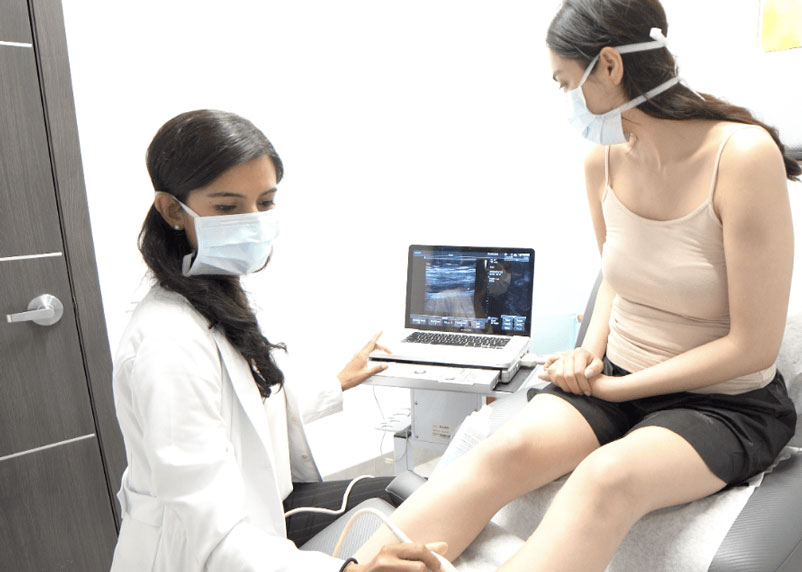What is the VenaSeal Procedure?
The VNUS Closure Procedure goes by many names, such as the VenaSeal procedure, the VenaSeal Closure System, and the vein glue treatment. This is widely considered to be one of the latest and safest minimally invasive procedures for chronic venous insufficiency, the root cause of most vein problems, including spider veins and varicose veins.
The VenaSeal procedure essentially involves the careful injecting of a medical-grade adhesive into the diseased saphenous vein responsible for your vein problems. The vein glue seals the diseased vein’s walls, and the accumulated blood reroutes into healthier leg veins, restoring optimal blood circulation to the heart. The diseased saphenous vein eventually gets metabolized by the body.

The VNUS Closure procedure is essentially performed using superglue for varicose veins. The FDA-approved, medical-grade adhesive used for this procedure is called cyanoacrylate glue, and it can effectively seal the diseased vein’s walls, turning them into hardened scar tissues. This medical glue has been used in medical procedures for decades, so we are confident of its safety.
The VenaSeal Closure System has been developed by Medtronic, the world’s leading manufacturer of medical devices. This treatment received FDA approval in 2015, so it’s not yet covered by all major medical insurance plans, making it slightly financially inaccessible to some patients. However, the VenaSeal procedure is also incredibly safe and minimizes the risk of a blood clot after vein ablation.

The Vein Treatment Clinic specializes in the VNUS Closure procedure for patients with chronic venous insufficiency and varicose veins. Our vein doctors examine your leg veins, review your medical history, and curate personalized vein treatment plans according to your specific goals and requirements. We also help patients with insurance coverage. Please schedule an appointment to explore your VenaSeal candidacy at our vein treatment clinics.
7 Advantages of VenaSeal Treatment
1. Minimally invasive treatment — no need for multiple injections
VenaSeal is a minimally invasive treatment. It’s performed as an in-office, outpatient procedure under local anesthesia — no surgeries, hospitalization, or downtime. Furthermore, the treatment only involves one small incision on the skin’s surface — you don’t need multiple injections, so the risk of post-treatment bruising is minimal.
2. Suitable for diseased veins with multiple branches
Ablative minimally invasive vein treatments, such as radiofrequency and laser ablation, aren’t suitable for diseased veins with multiple branches because the thermal energy can only be channeled in one particular direction. However, the vein glue used in the VenaSeal procedure spreads into the vein’s various branches, making it suitable for tortuous varicose veins.
3. No risk of lidocaine allergies
Most other vein treatments, such as radiofrequency ablation and laser ablation, must be performed using tumescent anesthesia, which contains lidocaine anesthetic. Some patients exhibit allergic reactions to lidocaine. However, the VenaSeal procedure doesn’t involve lidocaine anesthesia, so the risk of post-treatment allergies is negligible.
4. No risk of nerve injuries
Ablative vein treatments, such as radiofrequency and laser ablation involve using thermal energy to destroy the diseased vein. Because of the intense thermal energy, these procedures have a small risk of nerve injuries. VenaSeal doesn’t ablate the diseased vein using thermal energy, so the risk of nerve injuries is non-existent.
5. Suitable for the treatment of recurrent vein disease
The VenaSeal procedure is particularly suitable for patients with recurrent vein disease, i.e., you suffer from repeated instances of venous insufficiency. If other treatments haven’t worked in the past, your vein doctor may recommend the VenaSeal procedure to ensure more long-lasting results.
6. No need for compression stockings or ACE bandages
Most other minimally invasive vein treatments necessitate wearing ACE bandages and compression stockings after treatment to minimize the risk of vein disease recurrence. In most cases, you have to wear ACE bandages for a day and compression stockings for over a week. However, the VenaSeal procedure doesn’t necessitate wearing compression stockings.
7. Minimal post-treatment activity limitations
All minimally invasive treatments are extremely comfortable and convenient, allowing you to resume your daily activities without downtime. However, you have to generally avoid swimming and getting your legs wet, and most patients must avoid strenuous workouts. But VenaSeal doesn’t involve such restrictions — you can resume all of your daily activities immediately.
4 Drawbacks of VenaSeal Treatment
1. Lack of information about the long-term impact
The VenaSeal procedure is still relatively new, so its long-term impact isn’t very well known. Based on the available research, the VenaSeal procedure has a nearly perfect success rate with a negligible risk of complications, but its long-term effects are yet to be discovered.
2. Vein glue remains within the body as a medical implant
The cyanoacrylate glue used to seal the diseased vein’s walls remains within the body after the vein treatment. Even though the diseased vein is metabolized by the body, the vein glue remains as a medical implant. There’s no danger or risk associated with the medical implant, but some patients don’t like the idea of an implant in the body.
3. Minor risk of allergic reactions to vein glue
There’s an extremely minor and negligible risk of allergic reactions to the cyanoacrylate glue used for the VenaSeal procedure. However, our vein doctors perform thorough evaluations and tests to ensure you’re not allergic.
4. Not covered by all insurance plans
Is VenaSeal covered by Medicare? Well, the VenaSeal procedure was FDA-approved for the treatment of chronic venous insufficiency in 2015, so it’s not yet covered by all insurance plans. However, we provide hassle-free insurance verification, which you can claim by filling out the online form. Our insurance concierge will review the terms and conditions of your insurance plan to determine if you’re eligible for insurance coverage for your vein treatment.








